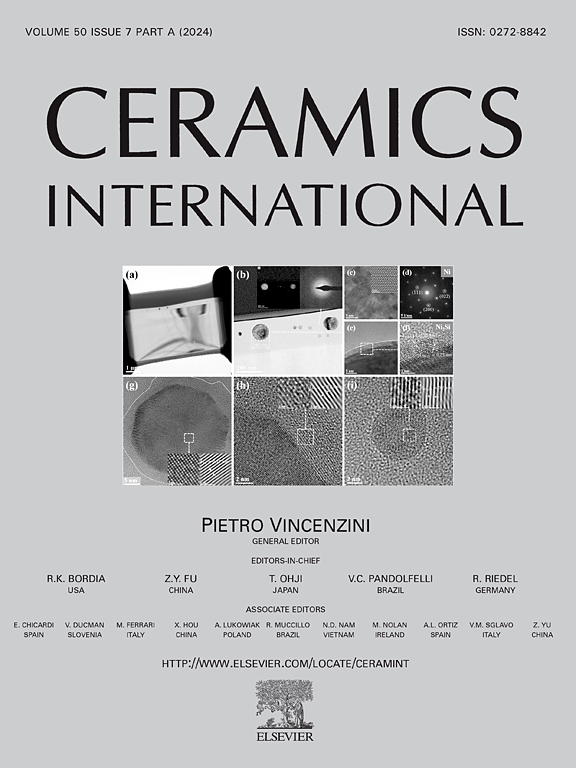激光熔覆原位TiC/TiB/Cr2B增强crmnnfeconi高熵合金复合涂层的摩擦腐蚀行为及机理
IF 5.6
2区 材料科学
Q1 MATERIALS SCIENCE, CERAMICS
引用次数: 0
摘要
摩擦腐蚀一直是海洋防护领域的难题。为了解决这一挑战,本研究采用激光熔覆原位合成技术制备了含有多个陶瓷增强相的CrMnFeCoNi高熵合金复合涂层。通过分析熔覆层的显微组织、显微硬度、电化学性能和摩擦腐蚀性能,研究了B4C和Ti的添加量(10%、20%和30%)对高熵合金复合镀层的影响。结果表明,碳化物和硼化物的协同作用显著增强了复合材料表面的钝化能力。C20涂层中掺量为20%的C20涂层具有最佳的耐蚀性。TiC颗粒的析出不仅抑制了位错运动,而且有效地阻断了腐蚀途径。当混合物添加量达到30%时,C30涂层的显微硬度最高,达到380.35 HV0.2,具有最佳的耐摩擦腐蚀性能。该研究为高熵合金复合涂层在恶劣海洋环境耦合摩擦腐蚀条件下的使用性能提供了理论和实践指导。本文章由计算机程序翻译,如有差异,请以英文原文为准。
Tribocorrosion behaviors and mechanisms of in-situ TiC/TiB/Cr2B reinforced CrMnFeCoNi high-entropy alloy composite coatings prepared by laser cladding
Tribocorrosion has long been a challenge in the field of marine protection. To address this challenge, this study used laser cladding in-situ synthesis to fabricate CrMnFeCoNi high-entropy alloy composite coatings containing multiple ceramic reinforcement phases. By analyzing the microstructure, microhardness, electrochemical properties, and tribocorrosion performance of the cladding layer, the effects of different B4C and Ti mixture additions (10 %, 20 %, and 30 %) on the high-entropy alloy composite coatings were studied. The results show that the synergistic effect of carbides and borides significantly enhances the passivation ability of the composite material's surface. The C20 coating with a 20 % mixture addition exhibited the best corrosion resistance. The precipitation of TiC particles not only suppressed dislocation motion but also effectively blocked corrosion pathways. When the mixture addition reached 30 %, the C30 coating achieved the highest microhardness of 380.35 HV0.2, demonstrating the optimal tribocorrosion resistance. This study provides both theoretical and practical guidance for the service performance of high-entropy alloy composite coatings under coupled tribocorrosion conditions in harsh marine environments.
求助全文
通过发布文献求助,成功后即可免费获取论文全文。
去求助
来源期刊

Ceramics International
工程技术-材料科学:硅酸盐
CiteScore
9.40
自引率
15.40%
发文量
4558
审稿时长
25 days
期刊介绍:
Ceramics International covers the science of advanced ceramic materials. The journal encourages contributions that demonstrate how an understanding of the basic chemical and physical phenomena may direct materials design and stimulate ideas for new or improved processing techniques, in order to obtain materials with desired structural features and properties.
Ceramics International covers oxide and non-oxide ceramics, functional glasses, glass ceramics, amorphous inorganic non-metallic materials (and their combinations with metal and organic materials), in the form of particulates, dense or porous bodies, thin/thick films and laminated, graded and composite structures. Process related topics such as ceramic-ceramic joints or joining ceramics with dissimilar materials, as well as surface finishing and conditioning are also covered. Besides traditional processing techniques, manufacturing routes of interest include innovative procedures benefiting from externally applied stresses, electromagnetic fields and energetic beams, as well as top-down and self-assembly nanotechnology approaches. In addition, the journal welcomes submissions on bio-inspired and bio-enabled materials designs, experimentally validated multi scale modelling and simulation for materials design, and the use of the most advanced chemical and physical characterization techniques of structure, properties and behaviour.
Technologically relevant low-dimensional systems are a particular focus of Ceramics International. These include 0, 1 and 2-D nanomaterials (also covering CNTs, graphene and related materials, and diamond-like carbons), their nanocomposites, as well as nano-hybrids and hierarchical multifunctional nanostructures that might integrate molecular, biological and electronic components.
 求助内容:
求助内容: 应助结果提醒方式:
应助结果提醒方式:


